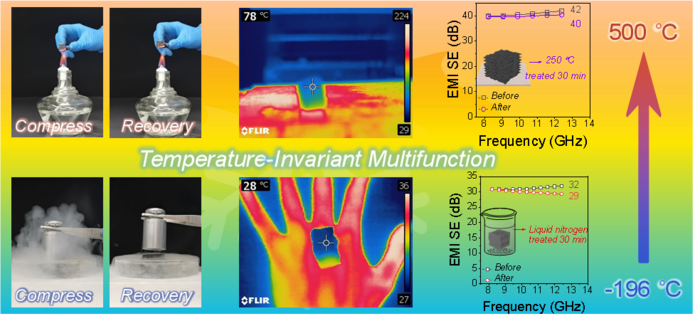Aerogel materials are used as protective materials in a variety of industries, such as electromagnetic interference shielding material for 5G technology, thermal insulating material in high-rise structures, and infrared stealth material for military applications.
 Scientists work to solve the problem that the performance of conventional protective aerogel materials deteriorates severely under harsh working conditions. Image Credit: Nano Research, Tsinghua University Press
Scientists work to solve the problem that the performance of conventional protective aerogel materials deteriorates severely under harsh working conditions. Image Credit: Nano Research, Tsinghua University Press
Current protective materials, on the other hand, frequently lose their protective capabilities when subjected to hard circumstances such as excessive temperatures, rendering them worthless.
Other protective materials lose elasticity, resulting in similar shortcomings. A team of Sichuan University researchers has discovered novel aerogel materials that can keep their functionality and super elasticity under severe temperatures.
On July 14th, 2022, the findings were published in Nano Research.
We aimed to solve the problem that the performance of conventional protective aerogel materials deteriorates severely under harsh working conditions.
Hai-Bo Zhao, Study Corresponding Author and Professor, College of Chemistry, Sichuan University
Polymer-based foam materials were frequently employed as protective materials prior to Zhao’s team’s discoveries. These materials demonstrated super elasticity and great compressibility but were unable to sustain these characteristics after the polymers’ melting temperatures.
Another extensively utilized material was metallic and ceramic foams, which were more stable throughout temperature ranges than their polymer-based foam counterparts but lacked the flexibility required for practical application.
A more scalable strategy includes the use of carbon aerogels, which have properties that adapts themselves well to thermal insulation and electromagnetic interference, such as large specific surface area, low density, superior electrical conductivity, and chemical and thermal stability.
However, carbon aerogels have limits due to their intrinsic characteristics. Carbon nanotubes became a popular approach for constructing super elastic carbon aerogels because they could preserve the requisite characteristics at high temperatures, but the methods were not scalable since the preparation required a lot of stages.
Zhao’s team was able to manufacture a polymer aerogel with super elasticity that performed in a temperature range of –196–500 °C utilizing a scalable and feasible approach by focusing on microstructure design.
Zhao added, “Unlike most carbon aerogels reported previously that usually possess poor mechanical properties, the prepared aerogel materials exhibit temperature-invariant superelasticity while maintaining multifunctional protective performance.”
Zhao is also a member of the Sichuan National Engineering Laboratory for Eco-Friendly Polymeric Materials and the Collaborative Innovation Center for Eco-Friendly and Fire-Safety Polymeric Materials.
Zhao’s approach combines bidirectionally oriented carbon/carbon aerogel composite multi-walled carbon nanotubes with a highly ordered carbon skeleton, which is one of the fundamental differences between this new method and prior methods.
Their scalable technique of obtaining the necessary microstructures — especially highly directed arch structures — comprises a bidirectional freezing and carbonization procedure to generate the carbon/carbon aerogels.
“The reported aerogel materials maintain superelasticity, high electromagnetic interference shielding effectiveness, thermal insulation and infrared stealth in a wide temperature range from –196–500 °C and after cyclic compression for hundreds of times. The most exciting aspect is the economic and simple preparation process, which laid the foundation of the potential practical application of the material,” stated Zhao.
Zhao stated that the next stage would be to make the aerogels available for commercial, military, and other applications.
He further commented, “We would like to promote the industrialization of the reported aerogel and further the application in 5G technology, high rise buildings, military use and more.”
Sichuan University’s Bo-Wen Liu, Min Cao, Yi-Ying Zhang, and Yu-Zhong Wang were the study’s other authors.
This study was supported by the National Natural Science Foundation of China, the Fundamental Research Funds for the Central Universities, the Young Elite Scientists Sponsorship Program by CAST, and the 111 Project.
Journal Reference:
Liu, B. W., et al. (2022) Multifunctional protective aerogel with superelasticity over –196 to 500 °C. Nano Research. doi:10.1007/s12274-022-4699-2.